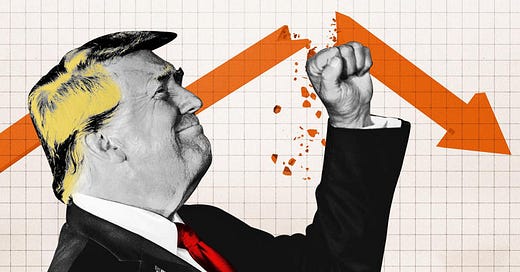How Trump’s Negligence Threatens American Lives: The True Cost of Political Neglect
From COVID-19 mismanagement to looming cuts in healthcare and food aid, Trump’s legacy and his latest bill in Congress could mean tens of thousands of preventable deaths. Here’s what every American ne
The U.S. Constitution charges the president with the solemn duty to “preserve, protect, and defend” the nation and its people. This obligation encompasses safeguarding citizens from both external threats and domestic harm, whether through measures related to national security, public health, or economic stability. Historically, this has meant responding to crises with urgency, upholding laws that protect vulnerable populations, and ensuring equitable access to essentials such as healthcare, food, clean air, and water. Yet when our sworn representatives serve special interests of the wealthy, rather than following evidence, or political expediency over human welfare, the consequences are measured not just in policy failures, but in lives sacrificed.
Donald Trump’s tenure and post-presidency agenda have tested these constitutional imperatives, with policies that systematically dismantled protections for marginalized communities, weakened public health infrastructure, and redirected resources away from critical safety nets. As his “One Big Beautiful Bill Act” advances through Congress, the protections of American lives, particularly those already struggling, grow exponentially.
Donald Trump’s policies and governance decisions have been linked to significant excess mortality across multiple domains, from public health failures to systemic dismantling of social and environmental safeguards. Below is an updated, evidence-driven accounting of the preventable deaths tied to his actions and inactions, incorporating the latest data and projections.
On February 7, 2020, Trump told Woodward:
“This is deadly stuff.”
“You just breathe the air, and that’s how it’s passed. … It’s also more deadly than even your strenuous flus.”
1. COVID-19: 180,000+ Preventable U.S. Deaths
Trump’s pandemic response exacerbated U.S. mortality:
Delayed mitigation: Early dismissal of COVID-19 as a “hoax” and resistance to masks, testing, and lockdowns accelerated the spread. The Lancet Commission estimated 40% of U.S. COVID-19 deaths (≈180,000 lives) could have been avoided with peer-nation mitigation strategies.
Ongoing toll: Despite pandemic “end” declarations, ≈200,000 annual COVID-19 deaths persist as of 2025, driven by vaccine skepticism and eroded public health infrastructure.
Undercounting: Pro-Trump counties underreported deaths by 30%, masking actual mortality.
On March 19, 2020, Trump explained his public messaging in a Bob Woodward interview:
“I wanted to always play it down. I still like playing it down, because I don’t want to create a panic.”
2. Domestic Policy: 24,000+ Annual Deaths from Austerity
Cuts to social programs and deregulation worsened preexisting vulnerabilities:
Environmental rollbacks: Rescinded pollution controls caused 22,000 annual deaths from air quality decline and toxic exposure.
SNAP and Medicaid cuts: Reductions to food assistance (from $6.20 to $5.00 daily) and healthcare access heightened malnutrition, chronic disease, and untreated conditions. The Commonwealth Fund projected 1.3 million job losses from 2026 cuts, exacerbating poverty-linked mortality.
Overdose crisis reversal: Trump’s cuts to SAMHSA and NIH halted naloxone distribution and addiction research, threatening a resurgence in fentanyl deaths after a 2024 decline[7]. Naloxone is a life-saving medication that rapidly reverses opioid overdoses.
3. Global Health: 238,000+ Annual Deaths from Aid Cuts
Slashing foreign aid disproportionately harmed low-income nations:
HIV/AIDS: Halting PEPFAR funding jeopardized antiretroviral therapy for 1 million people, risking 176,000 annual deaths.
Malaria and TB: Cancelled USAID contracts led to 15 million additional malaria cases (107,000 deaths) and 62,000 TB deaths in 2025.
Humanitarian crises: Freezing $20 billion in aid worsened famine and displacement for 305 million globally, with child mortality spiking in conflict zones.
4. Worker Safety: 1,100+ Preventable Deaths from Deregulation
Eroding workplace protections reversed decades of progress:
Silica rule delay: Blocking OSHA’s silica dust limits left miners exposed, preventing 1,100 fewer deaths and 3,750 fewer illnesses.
Rising fatalities: AFL-CIO reported 140,587 U.S. worker deaths in 2023 (385/day), disproportionately affecting older workers, immigrants, and minorities.
5. Long-Term Health Inequities
Systemic neglect deepened preexisting disparities:
Avoidable mortality: 23% of 2023 U.S. deaths (≈700,000) were excess compared to peer nations, driven by cardiometabolic diseases, gun violence, and drug overdoses.
Life expectancy decline: U.S. life expectancy dropped 1.13 years under Trump, the steepest fall since WWII.
The Looming Impact of Trump’s “Big Bill”
The “One Big Beautiful Bill Act,” currently navigating the Senate via reconciliation, threatens to compound Trump’s legacy of preventable mortality. Key provisions include:
Permanent tax cuts for the wealthy: Extending the 2017 Trump tax cuts, which disproportionately benefit the top 1%, while reducing federal revenue by $1.5 trillion over a decade. This deficit explosion risks future austerity measures targeting Medicaid, Social Security, and other lifelines.
Medicaid cuts: Restricting eligibility and retroactive coverage could strip 8.6 million low-income, elderly, and disabled Americans of healthcare access, according to the Congressional Budget Office (CBO). Studies link Medicaid loss to a 6% increase in mortality within five years.
SNAP reductions: Tightening work requirements would remove 4 million from food assistance, exacerbating hunger and diet-related diseases in poverty-stricken regions.
Border militarization: Allocating $350 billion for deportations and wall construction diverts funds from disaster preparedness and healthcare, leaving communities like Puerto Rico even more vulnerable to climate-driven crises.
These cuts, paired with the bill’s $1.6 trillion in deficit reduction through social program austerity, align with Trump’s pattern of sacrificing vulnerable populations to subsidize corporate and elite interests. Meanwhile, the bill’s $150 billion military boost and $12 billion nuclear modernization prioritize geopolitical posturing over domestic welfare—a stark contradiction of the president’s duty to shield citizens from harm.
Projected toll:
Medicaid losses: An estimated 13,000–27,000 annual deaths from untreated chronic conditions, based on Harvard mortality models.
SNAP cuts: 1,200+ annual deaths from malnutrition and hunger-related illnesses, per Feeding America.
Environmental deregulation: Continued rollbacks could sustain 22,000+ yearly deaths from pollution.
A Legacy of Calculated Neglect
Trump’s policy choices—prioritizing tax cuts for the wealthy, deregulation, and punitive austerity—have left a trail of preventable deaths domestically and globally. The “One Big Beautiful Bill” codifies this neglect, trading human security for ideological wins. As Sen. Ron Johnson (R-Wis.) warned, the legislation is “completely unsustainable,” while Elon Musk condemned its “cruelty” toward working-class Americans.
The president’s oath to protect demands more than rhetoric; it requires policies that affirm life, dignity, and equity. Until governance realigns with this mandate, the toll of preventable deaths will remain a damning indictment of leadership—and a betrayal of the Constitution’s most sacred charge.
Peer-reviewed studies and federal data suggest hundreds of thousands of lives were cut short by:
Delayed pandemic response
Dismantled safety nets
Deregulated environmental and workplace protections
Abandoned global health commitments
These figures underscore a governance philosophy that treats human life as collateral in pursuit of ideological and fiscal agendas. The toll is measurable not just in statistics, but also in communities fractured by loss and a world that is left more vulnerable to future crises.
At a campaign event in Sioux Center, Iowa, on January 23, 2016, Trump said:
“I could stand in the middle of Fifth Avenue and shoot somebody, and I wouldn't lose any voters, OK? It's, like, incredible.”
Trump’s Fifth Avenue remark is more than rhetorical bravado; it encapsulates a troubling philosophy of leadership where inhumanity and lack of accountability are not only possible but openly acknowledged.
Sources:
EPI, AFL-CIO, APHA
JAMA Health Forum, BU Study
Boston University Tracking Initiative
Wikipedia, STAT News
Medical Xpress
TFAH Report
ICVA Network
The Nation
JAMA Study
CDC Data
Commonwealth Fund
AS/COA
Reuters Investigation







Please let’s never forget what we’re doing to the children who are being left defenseless because of the “brown-person” bounty that’s on their parents’ heads. There are literally toddlers facing judges and being asked “do you understand” — then, because THEY ARE BABIES — communicating by raising their stuffed animal.
Can people that are enabling Trump even though he is clearly incapable of the role of commander in chief be held liable and prosecuted when all of this insanity implodes??